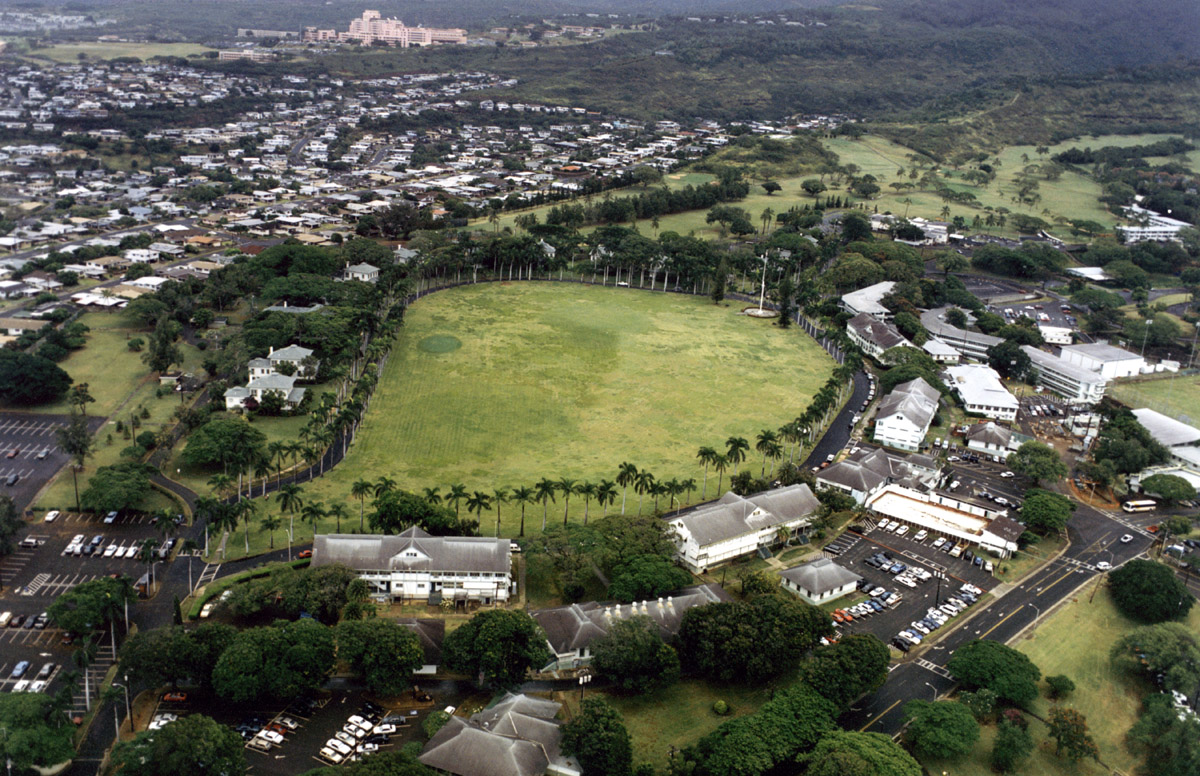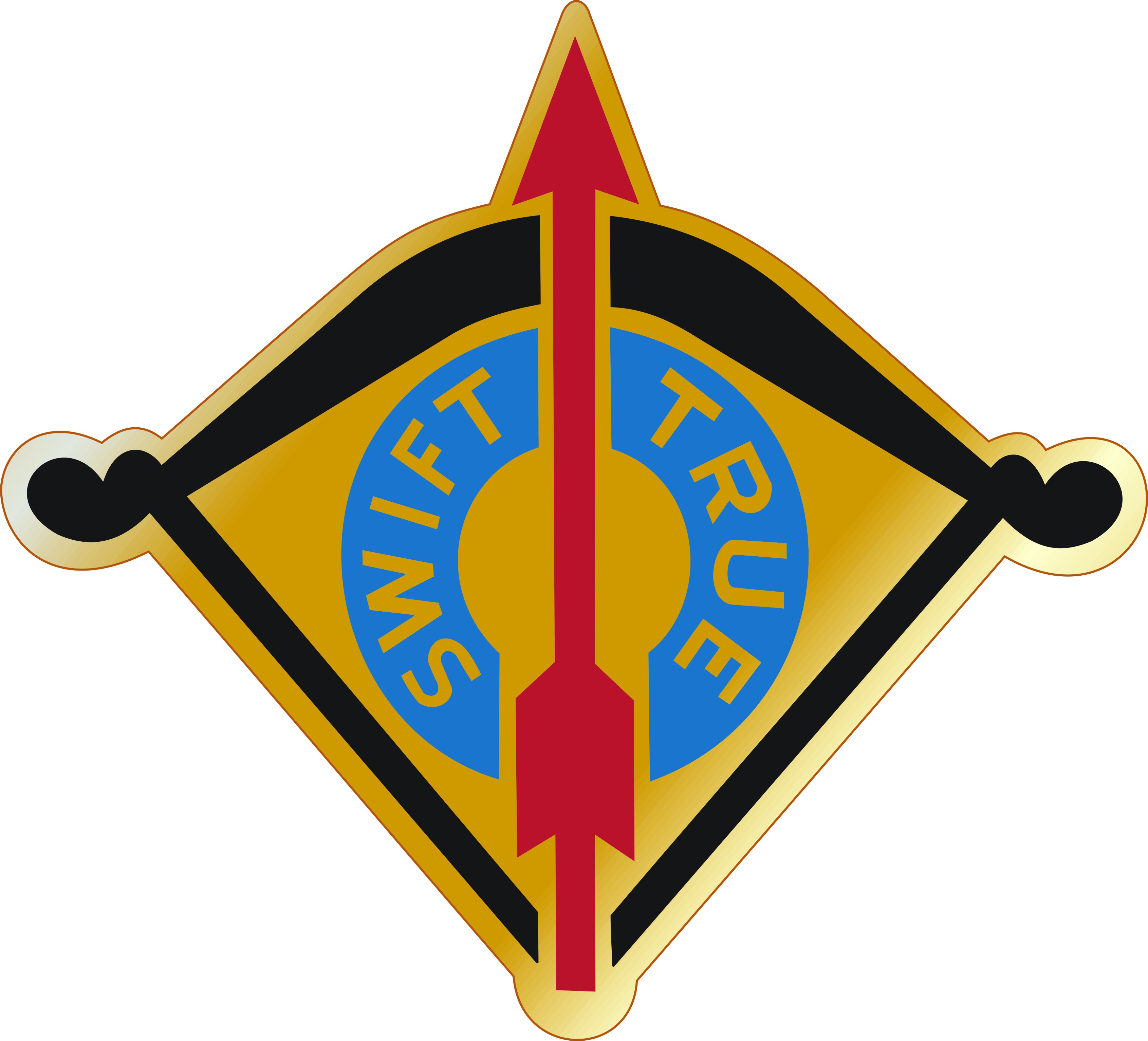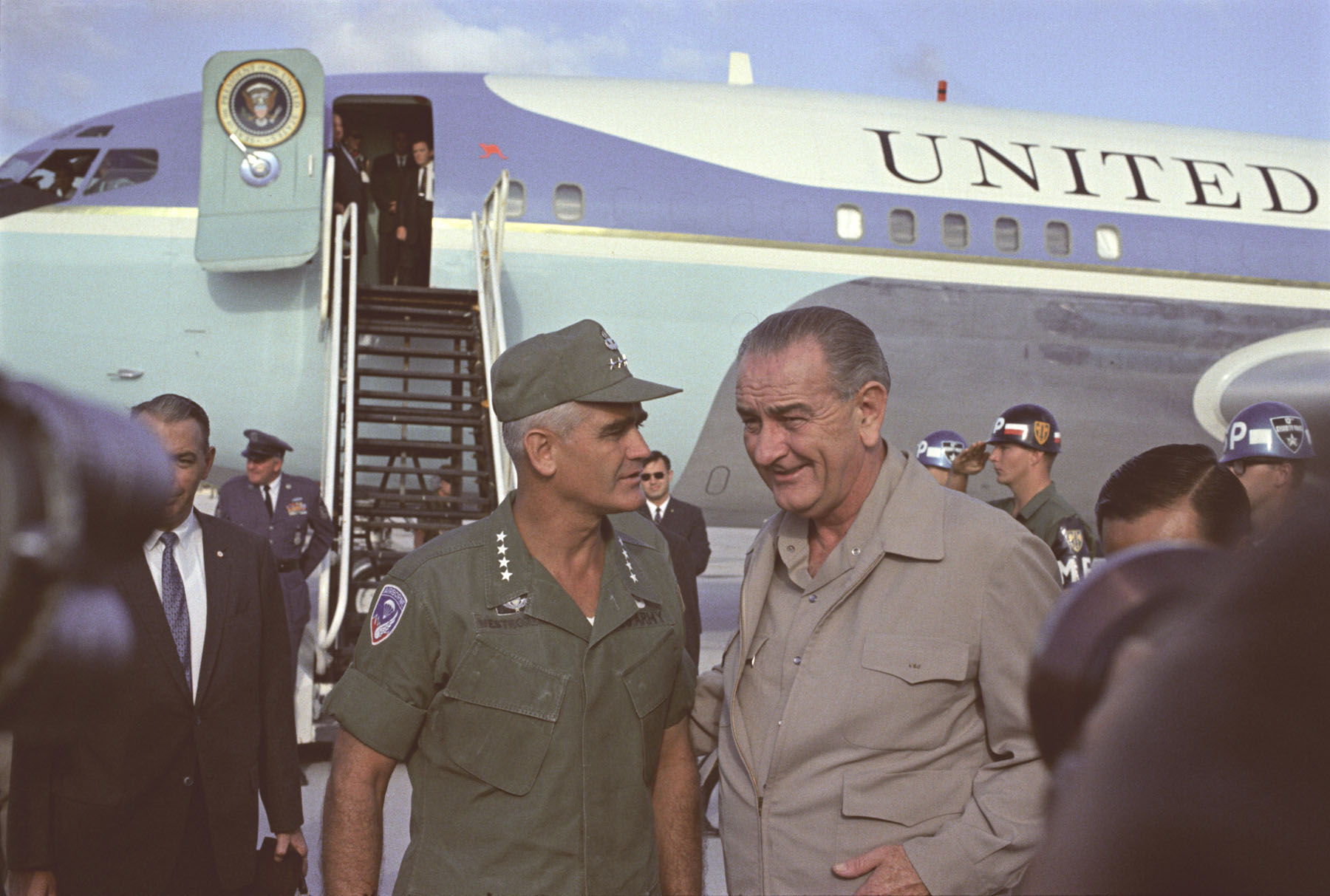|
196th Light Infantry Brigade
The 196th Infantry Brigade ("Chargers"), also known as the Charger Brigade was first formed on 24 June 1921 as part of the United States Army Reserve's 98th Division with the responsibility of training soldiers. World War II During World War II, the 98th initially defended Kauai, Hawaii and Maui, Hawaii, and finally responsible for defending Oahu, Hawaii later in the war. The Division began intensive training in May 1945 to prepare for the invasion of Japan, but the war ended before they could depart Hawaii. However, the unit arrived in Japan for occupation duty as the 3rd Platoon, 98th Reconnaissance Troop Mechanized, of the 98th Infantry Division, where it eventually was inactivated on 16 February 1946, in Charlotte, NC. Service in the Vietnam War The brigade was reactivated in September 1965 at Fort Devens Massachusetts, where it was originally scheduled to be sent to the Dominican Republic. Instead, the Army rushed it to South Vietnam, the Brigade departing on 15 July 1966 v ... [...More Info...] [...Related Items...] OR: [Wikipedia] [Google] [Baidu] |
Fort Shafter
Fort Shafter is a census-designated place Page 4/ref> located in the City and County of Honolulu, Hawai‘i. It is the headquarters of the United States Army Pacific, which commands most Army forces in the Asia-Pacific region with the exception of Korea. Geographically, Fort Shafter extends up the interfluve (ridgeline) between Kalihi and Moanalua valleys, as well as onto the coastal plain (as Shafter Flats) at Māpunapuna. A portion of the area is also known as the Palm Circle Historic District; it is listed on the National Register of Historic Places and has been further designated as a U.S. National Historic Landmark. It is also known as Palm Circle or 100 Area. History Fort Shafter is the oldest military base on Oahu and celebrated its 100th birthday on 22 June 2007. Fort Shafter has been home to the senior Army headquarters in Hawaii for a century. Construction began in 1905 on the ahupua'a of Kahauiki, former Hawaiian crown lands that were ceded to the United States ... [...More Info...] [...Related Items...] OR: [Wikipedia] [Google] [Baidu] |
Operation Attleboro
Operation Attleboro was a Vietnam War search and destroy operation initiated by the 196th Light Infantry Brigade with the objective to discover the location(s) of People's Army of Vietnam (PAVN) and Viet Cong (VC) base areas and force them to fight. The operation was named after Attleboro, Massachusetts, where the brigade had been formed. Operation Attleboro grew to be the largest series of air mobile operations to that time, involving all or elements of the 196th Brigade, 25th Infantry Division, 1st Infantry Division and a brigade of the 4th Infantry Division, as well as numerous Army of the Republic of Vietnam and Regional Forces/Popular Forces and Nùngs. In the end, the operation became a Corps operation commanded by II Field Force, Vietnam. Background In late 1966 interdiction remained a high priority for US forces, and, until the dry season began in earnest, COMUSMACV General William Westmoreland's primary concern remained blocking the three infiltration corridors ... [...More Info...] [...Related Items...] OR: [Wikipedia] [Google] [Baidu] |
198th Infantry Brigade (United States)
The 198th Infantry Brigade, was first formed as part of the United States Army Reserve's 99th Infantry Division (United States), 99th Division. It was active from 1967 through 1971 and has been active since 2007 as an Infantry Training Brigade as part of the United States Army Infantry School, US Army Infantry School at Fort Benning, Georgia (U.S. state), Georgia. Operational history Vietnam War During the years of 1967–1971 as part of the Vietnam War the 198th was part of the United States Army's Americal Division, 23rd "Americal" Infantry Division. In 1968, elements of the 198th Infantry Brigade, under the leadership of Lieutenant Colonel Robert B. Nelson, participated in the Battle of Kham Duc. On 21 November 1969, Joseph G. Clemons, Colonel Joseph G. Clemons, (of Battle of Pork Chop Hill, Pork Chop Hill fame), assumed command of the 198th Infantry Brigade. Order of battle *Headquarters & Headquarters Company * 1st Battalion, 6th Infantry Regiment (United States), 6th I ... [...More Info...] [...Related Items...] OR: [Wikipedia] [Google] [Baidu] |
11th Infantry Brigade (United States)
The 11th Infantry Brigade is an inactive infantry brigade of the United States Army. It was first formed as part of the 6th Division during World War I. It is best known for its service with the 23rd Infantry Division from 1967 through 1971 in the Vietnam War as a light infantry brigade. The brigade is known for its responsibility in the My Lai Massacre. History World War I The headquarters of the 11th Infantry Brigade was constituted on 16 November 1917 in the Regular Army as part of the 6th Division and organized on 4 December at Camp Forrest. The brigade included the 51st and 52nd Infantry Regiments, as well as the 17th Machine Gun Battalion. The 51st and 52nd were formed in June of that year from personnel of the 11th Infantry Regiment. The Brigade began its overseas service in June 1918 and spent 43 days in combat in France. It was commanded by Brigadier General William Dashiell. After the end of the war, it spent six months on occupation duty with the 6th Divisi ... [...More Info...] [...Related Items...] OR: [Wikipedia] [Google] [Baidu] |
23rd Infantry Division (United States)
The Americal Division was an infantry division of the United States Army during World War II, briefly in the mid 1950s and the Vietnam War. The division was activated 27 May 1942 on the island of New Caledonia. In the immediate emergency following Attack on Pearl Harbor, Pearl Harbor, the United States had hurriedly sent a task force to defend New Caledonia against a feared Japanese attack. This division was the only division formed outside of United States territory during World War II (a distinction it would repeat when reformed during the Vietnam War). At the suggestion of a subordinate, the division's commander, Major General Alexander Patch, requested that the new unit be known as the ''Americal Division''—the name being a contraction of "American, New Caledonian Division". This was unusual, as with the exception of the Philippine Division (United States), Philippine Division, all other U.S. divisions were known by a number. After World War II the Americal Division was o ... [...More Info...] [...Related Items...] OR: [Wikipedia] [Google] [Baidu] |
4th Infantry Division (United States)
The 4th Infantry Division is a Division (military), division of the United States Army based at Fort Carson, Colorado. It is composed of a division headquarters battalion, three brigade combat teams (two Stryker and one armor), a combat aviation brigade, a division sustainment brigade, and a division artillery. The 4th Infantry Division's official nickname, "Ivy", is a play on words of the Roman numeral ''IV'' or 4. Ivy leaves symbolize tenacity and fidelity which is the basis of the division's motto: "Steadfast and Loyal". The second nickname, "Iron Horse", has been adopted to underscore the speed and power of the division and its soldiers. World War I On 19 November 1917, about United States declaration of war on Germany (1917), seven months after American entry into World War I on 6 April 1917, the United States Department of War, War Department directed the organization of the 4th Division at Camp Greene, North Carolina, around a cadre of Regular Army troops that had bee ... [...More Info...] [...Related Items...] OR: [Wikipedia] [Google] [Baidu] |
25th Infantry Division (United States)
The 25th Infantry Division (nicknamed "Tropic Lightning") is a United States Army division based at Schofield Barracks in Hawaii. The division, which was activated on 1 October 1941 in Hawaii, conducts military operations primarily in the Asia-Pacific region. Its present deployment is composed of light infantry and aviation units. Tropic Lightning soldiers regularly train with other U.S. military branches to practice and maintain joint operations capabilities. The climate and terrain of the Pacific region demands Tropic Lightning soldiers be able to operate in physically demanding and harsh environments. In 2014, the division opened the Jungle_warfare#United_States, Jungle Operations Training Center—the first such school in the Army since the closing of the old Jungle Warfare School at Fort Sherman, Panama Canal Zone. Joint operations and training with partner states herald a new chapter in the history of Tropic Lightning—America's Pacific Division. The division was original ... [...More Info...] [...Related Items...] OR: [Wikipedia] [Google] [Baidu] |
101st Airborne Division
The 101st Airborne Division (Air Assault) ("Screaming Eagles") is a light infantry division (military), division of the United States Army that specializes in air assault military operation, operations. The 101st is designed to plan, coordinate, and execute brigade-sized air assault operations that can be conducted in one period of darkness, at distances up to 500 nautical miles, to seize key terrain and hold it for up to 14 days. In recent years, the 101st was active in foreign internal defense and counterterrorism operations in Iraq, in Afghanistan in 2015–2016, and in Syria, as part of Operation Inherent Resolve in 2018–2021. Established in 1918, the 101st Division was first constituted as an airborne unit in 1942. During World War II, it gained renown for its role in Operation Overlord (the Normandy landings, D-Day landings and American airborne landings in Normandy, airborne landings on 6 June 1944, in Normandy, France); Operation Market Garden; the liberation of the ... [...More Info...] [...Related Items...] OR: [Wikipedia] [Google] [Baidu] |
Chu Lai Base Area
Chu Lai Base Area (also known as Chu Lai Combat Base or simply Chu Lai or Kỳ Hà) is a former U.S. Marine Corps, U.S. Army and Army of the Republic of Vietnam (ARVN) base in Chu Lai in central Vietnam. Kỳ Hà Air Facility was part of the installation and was located in the northern half, Chu Lai Air Base was part of the installation and was located to the south-east. History 1965 The base was located on the Kỳ Hà peninsula north of National Route 1 (Vietnam), Highway 1 approximately southeast of Da Nang. On 6 May units from the ARVN 2nd Division (South Vietnam), 2nd Division and 3rd Battalion, 9th Marines secured the Chu Lai area. On 7 May, the 3rd Marine Expeditionary Brigade (United States), 3rd Marine Expeditionary Brigade (3rd MEB), composed of the 4th Marine Regiment, 3rd Reconnaissance Battalion, elements of Marine Aircraft Group 12 (MAG-12) and Seabee, Naval Mobile Construction Battalion 10 landed at Chu Lai to establish a Chu Lai Air Base, jet-capable airfield a ... [...More Info...] [...Related Items...] OR: [Wikipedia] [Google] [Baidu] |
Task Force Oregon
Task Force Oregon, was a United States Army division-sized unit composed of three separate infantry brigades, active in Quảng Ngãi and Quảng Tín Provinces, South Vietnam from April to September 1967 when it was redesignated the 23rd Infantry Division (Americal). Purpose and composition In early April 1967 MACV gave instructions to commence the Task Force Oregon plan, which involved the movement of an Army task force to Đức Phổ and Chu Lai area to allow the 1st Marine Division to move north to Danang to support the 3rd Marine Division in northern I Corps. COMUSMACV General William Westmoreland appointed his chief of staff MG William B. Rosson to command the unit, designated Oregon after Rosson's home state. MG Rosson reported directly to III Marine Amphibious Force which controlled I Corps, however he was generally free to manoeuvre his brigades subject to maintaining the defense of Chu Lai Air Base. Task Force Oregon originally comprised the following units: * ... [...More Info...] [...Related Items...] OR: [Wikipedia] [Google] [Baidu] |
I Corps (South Vietnam)
I Corps () was a corps of the Army of the Republic of Vietnam (ARVN), the army of the nation state of South Vietnam that existed from 1955 to 1975. It was one of four corps of the ARVN. This was the northernmost region of South Vietnam, bordering North Vietnam at the Vietnamese Demilitarized Zone (DMZ). These five provinces are Quảng Trị Province, ( Khe Sanh, Đông Hà, Quảng Trị City), Thừa Thiên-Huế Province, (Phu Bai, Huế City), Quảng Nam Province, (Đà Nẵng, Hội An), Quảng Tín Province, (Tam Kỳ, Chu Lai) and Quảng Ngãi Province, (Quảng Ngãi). I Corps became operational in November 1957. Among its formations and units were the ARVN 1st Division. The I CTZ, later Military Region 1, was partnered with the U.S. III Marine Expeditionary Force and the XXIV Corps. Lam Son 719 General Hoàng Xuân Lãm was given responsibility for the I Corps Tactical Zone in 1967. He coordinated the South Vietnamese Operation Lam Sơn 719 offensive which ai ... [...More Info...] [...Related Items...] OR: [Wikipedia] [Google] [Baidu] |
William Westmoreland
William Childs Westmoreland (26 March 1914 – 18 July 2005) was a United States Army general, most notably the commander of United States forces during the Vietnam War from 1964 to 1968. He served as Chief of Staff of the United States Army from 1968 to 1972. In Vietnam, Westmoreland adopted a strategy of attrition against the Viet Cong and the North Vietnamese Army, to drain them of manpower and supplies. He also made use of the United States' superiority in artillery and air power, employed in tactical confrontations and in relentless strategic bombing of North Vietnam. As time went on and success was not gained, public support for the war diminished, especially after the Battle of Khe Sanh and the Tet Offensive in 1968. When he was reassigned as Army Chief of Staff, United States military forces in Vietnam had reached a peak of 535,000 personnel. Westmoreland's strategy was ultimately politically and militarily unsuccessful. Growing United States casualties and the dra ... [...More Info...] [...Related Items...] OR: [Wikipedia] [Google] [Baidu] |






